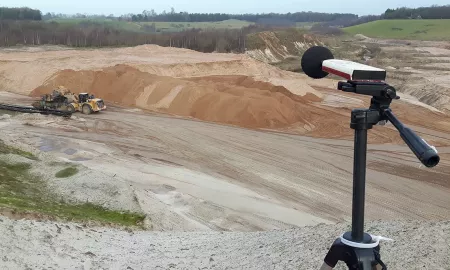In light of recent changes to health and safety regulations for mines, which came into force last year, mining expert, Philip Shead, a specialist ventilation consultant at SOCOTEC, explores which factors mine operators need to take into account to optimise air quality and ensure the wellbeing of their employees.

In light of recent changes to health and safety regulations for mines, which came into force last year, mining expert, Philip Shead, a specialist ventilation consultant at SOCOTEC, explores which factors mine operators need to take into account to optimise air quality and ensure the wellbeing of their employees.
The Mines Regulations 2014 came into force in April 2015, replacing all previous health and safety mining laws in the UK. The new legislation has been created to simplify a previously complex set of regulations, to make it easier for mine operators to achieve the highest standards of workplace safety and ensure the health and wellbeing of those working in their mines.
In addition to streamlining previous mining law, the new regulations are now less prescriptive, being based more on risk assessments carried out for a site to achieve set safety goals, rather than specifying particular measures. Under the legislation, the principal duty holder is now the mine operator, not the manager. Operators are required to assess the safety hazards in their mine and use this to devise a suitable system to minimise the risk to employees and visitors. Despite these changes, the legislation still stipulates a workmen’s inspector for each mine to liaise with workers and ensure they are satisfied with the safety measures in place.
One of the key areas where the Mines Regulations 2014 differ from previous legislation is in the air quality requirements, particularly for stone mines. Incorporating recommendations from a number of previous regulations, such as the Control of Substances Hazardous to Health (COSHH), the law stipulates that mine operators take steps to optimise the ventilation systems in the underground sections of their facilities to protect employees’ health, safety and wellbeing.
Regardless of the material being extracted from the mine, it is important to have in place stringent ventilation measures. Given the depth of the tunnels and caverns, it can be difficult for fresh air from the surface to circulate naturally. If sufficient protocols are not taken by the mine operators, these circumstances could leave workers at serious risk of health issues, ranging from heat stroke in the short-term, to respiratory problems in the long-term.
But which air quality risks should stone mine operators look out for, and how can they be tackled to ensure continued health, safety and wellbeing standards? The following are three key areas that mine operators should focus on to optimise air quality, as well as an overview on the importance of ventilation systems to maintaining a healthy and safe environment.
Clearing dust from the air
A key issue in stone mines that has to be tackled to optimise air quality is the presence of dust. The machinery used to cut into the rock face can leave clouds of airborne dust, while the passage of vehicles through the mine tunnels can disturb dust settled on the floor, adding to concentrations in the air.
The clouds of dust are more than an irritation. They can limit visibility for the operators of heavy machinery and vehicles, which can present a hazard to employees walking through the mine. More importantly, without proper precautions, this dust can easily be inhaled by workers, not only restricting breathing, but potentially inflaming lung tissue. Over the long term, if not dealt with properly, this inflammation can cause respiratory problems, impacting on an employee’s quality of life, and even their ability to work.
The Mines Regulations 2014 incorporates the requirements of the Inhalable Dust Regulations 2007, and specifically makes reference to dust as a health and safety hazard. In section 218 of Regulation 43: Ventilation, the legislation identifies dust as one of the key risks that mine operators have a duty to manage through the use of adequate ventilation at the mine head and throughout the mine itself.
Staying cool
Another air quality challenge that mine operators must overcome to maintain a comfortable and safe working environment is that of high underground temperatures.
At depth, without adequate ventilation, air temperatures can easily reach uncomfortably high levels, with implications for health and wellbeing. Excess heat makes it harder for the human body to regulate its internal temperature and prevents cooling down. This can lead to serious acute issues, such as heat stroke, where the individual’s body temperature becomes too high, leading to fatigue and dizziness, and potentially seizures and fainting.
In consideration of the health risks of high temperatures, the Mines Regulations 2014 does stipulate that mine operators ensure they have systems in place to help maintain a comfortable and safe working environment. Regulation 43: Ventilation does not state a specific maximum air temperature for stone, or any other, mines, but does recommend that mine operators do all they can to maintain an underground temperature that is “reasonable” for the nature of the work being carried out. This provides considerable flexibility for mine operators, giving them the freedom to take into account the differences in heat emitted across the mine and allow for variation in temperature throughout the working day, as long as it does not impact on employee health and wellbeing. Appropriate ventilation, nevertheless, remains key to managing temperature by removing warm air and replacing it with fresh, cool air from the surface.
Venting vehicle emissions
Emissions from diesel engines and motors are another air quality hazard that mine operators need to manage to optimise health and safety for workers.
All the heavy machinery and vehicles used in mines, whether for cutting or transporting material to the surface, or for carrying workers, have to be powered by diesel, rather than petrol. Diesel engines emit lower levels of carbon dioxide (CO2), reducing the risk of dangerous carbon monoxide (CO) production due to incomplete combustion caused by low oxygen levels in enclosed spaces.
However, diesel engines emit nitrous oxides (NOx) and fine particles, known as diesel particulate matter (DPM). Exposure to both can irritate eyes and the respiratory tract, causing breathlessness, and can also lead to headaches and dizziness. In the long term, if action isn’t taken to limit concentrations in the air, diesel fumes have been linked with cardiovascular disease and lung cancer.
Under the Mine Regulations 2014, mine operators have a duty to take steps to minimise concentrations of diesel and other motor emissions from the areas of the mine frequented by workers. Again, the legislation does not specify a maximum concentration of diesel fumes, but advises that mine operators take appropriate measures, including ventilation, to ensure oxygen levels underground do not drop below 19 per cent by volume.
Addressing other air quality issues
While dust, emissions and heat are the main risks to optimum air quality faced by the operators of stone mines, they are not the only hazards that need to be managed.
The Mine Regulations 2014 also require mine operators to assess and mitigate the risk of flammable or explosive vapours in their mine, whatever the material being extracting. While the risk posed by gases, such as methane, in stone mines is far lower than that of coal mines, operators nevertheless need to identify the risk to the site and employees, and take steps to minimise the build-up of such materials.
The legislation also recommends that mine operators address the potential for nuclear contamination in their mines. Radioactive minerals do occur in the Earth’s crust, and natural gases, such as radon, can build up in enclosed spaces, leading to long-term health issues related to low-level radiation exposure. Geological surveys and radiation readings should be carried out on site to identify any potential radiation risk, so that steps can be taken to manage the hazard.
Humidity in the atmosphere should also be taken into account in the mine. Not only can airborne moisture lead to rusting and premature degrading of heavy machinery and other mechanical equipment, it can also have repercussions for human health too. For example, it can exacerbate the effects of hot air, increasing the risk of heat stroke underground, and can also help create the ideal conditions for mould to thrive, the spores of which can lead to respiratory issues for workers.
With the health effects of poor air quality in mind, it is imperative that mine operators ensure they have the ventilation systems in place to keep a good supply of fresh air even in the deepest parts of their facility. But how can they achieve this?
Key to effective ventilation
To mitigate the impact of these safety issues on workers, mine operators can take a number of measures, from maintaining machinery to minimise emissions, to providing workers with personal protective equipment. Nevertheless, to comply with the Mine Regulations 2014, they have to ensure that there is a suitable ventilation system below ground to effectively manage the air quality risk.
However, it offers considerable flexibility with regards to how this can be achieved, advising that the type of ventilation used will depend on the type of mine and the potential hazards present, as well as the extent to which each part of the mine needs ventilating. It also recommends that no fan or similar equipment be installed anywhere in the mine unless a survey of the likely effects of the fan on the passage of air has first been carried out, and a report created detailing the solution’s size, type and its proposed location.
To meet the requirements of the new legislation, and optimise safety for workers, mine operators need to carry out a comprehensive risk assessment of every part of their mine. This can be undertaken with air quality experts, who can provide support in identifying any safety issues and help operators determine what risks need to be addressed to safeguard the wellbeing of workers.
From the risk assessment, experts can build a three-dimensional computer model of the natural movement of air inside the mine. This can then be used to design an effective ventilation system for the site to ensure the optimum movement of air to minimise the concentration of fumes and other hazardous materials. This 3D model is also crucial to help mine operators devise a suitable escape route for workers in the event of a fire.
Carrying out these measures, and working with the support of air quality experts, mine operators can ensure that the environment on their premises is the best it can be for workers on the site.
Keeping up to speed with air quality
The regulations relating to air quality, and to workplace health and safety in general, are becoming more stringent. As such, it is imperative that mine operators do all they can to keep up to date with the latest legislation, put the correct systems in place in their facilities to remain compliant and to manage any risks to worker wellbeing relating to dust, fumes and other airborne hazards.
Mine operators should work closely with air quality experts to ensure they fully understand the safety risks and the natural passage of air throughout the site. In doing so, they can be confident they have the information they need to design and maintain the most effective system for their mine, meeting the requirements of the regulations and making sure the team members in their care are comfortable and, above all, safe as they go about their working day.
*This article was first published by Health & Safety International magazine, officially Europe’s largest audited safety magazine. It is published five times a year and concentrates on the latest personal protective equipment for dangerous industries, or places of work where injuries might occur. The magazine includes in-depth articles, case studies and product reports that educate the reader in employee protection.
HSI is part of Bay Publishing which is a focussed and professional publishing company concentrating solely on the personal protection, health & safety, process emissions control industries. Products include: Health & Safety Middle East and Africa, AWE International and OSE Directory.
Want to find out more about SOCOTEC's air quality monitoring services?

You might also like






Add new comment